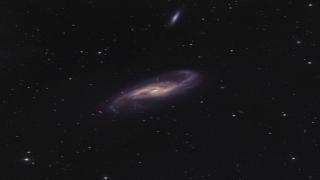Dullo, Bililign T.; Gil de Paz, Armando; Knapen, Johan H.
Referencia bibliográfica
The Astrophysical Journal
Fecha de publicación:
2
2021
Revista
Número de citas
19
Número de citas referidas
17
Descripción
We investigate the nature of the relations between black hole (BH) mass (MBH) and the central velocity dispersion (σ) and, for core-Sérsic galaxies, the size of the depleted core (Rb). Our sample of 144 galaxies with dynamically determined MBH encompasses 24 core-Sérsic galaxies, thought to be products of gas-poor mergers, and reliably identified based on high-resolution Hubble Space Telescope imaging. For core-Sérsic galaxies, i.e., combining normal-core (Rb < 0.5 kpc) and large-core galaxies (Rb ≳ 0.5 kpc), we find that MBH correlates remarkably well with Rb such that ${M}_{\mathrm{BH}}\propto {R}_{{\rm{b}}}^{1.20\pm 0.14}$ (rms scatter in log MBH of Δrms ∼ 0.29 dex), confirming previous works on the same galaxies apart from three new ones. Separating the sample into Sérsic, normal-core and large-core galaxies, we find that Sérsic and normal-core galaxies jointly define a single log-linear MBH-σ relation MBH ∝ σ4.88±0.29 with Δrms ∼ 0.47 dex; however, at the high-mass end, large-core galaxies (four with measured MBH) are offset upward from this relation by (2.5-4) × σs, explaining the previously reported steepening of the MBH-σ relation for massive galaxies. Large-core spheroids have magnitudes MV ≲ -23.50 mag, half-light radii Re ≳ 10 kpc, and are extremely massive, M* ≳ 1012 M☉. Furthermore, these spheroids tend to host ultramassive BHs (MBH ≳ 1010 M☉) tightly connected with their Rb rather than σ. The less popular MBH-Rb relation exhibits ∼62% less scatter in log MBH than the MBH-σ relations. Our findings suggest that large-core spheroids form via multiple major "dry" merger events involving super/ultramassive BHs, consistent with the flattening of the σ-LV relation observed at MV ≲ -23.5 mag.
Proyectos relacionados

Las Galaxias Espirales: Evolución y Consecuencias
Nuestro grupo pequeño esta bien conocido y respetado internacionalmente por nuestro trabajo inovativo e importante en varios aspectos de la estructura y la evolución de las galaxias espirales cercanas. Usamos principalmente observaciones en varias longitudes de onda, explotando las sinergías que nos permiten responder a las cuestiones más
Johan Hendrik
Knapen Koelstra